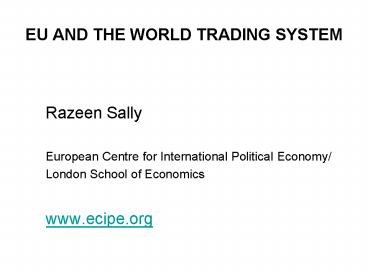EU AND THE WORLD TRADING SYSTEM - PowerPoint PPT Presentation
1 / 37
Title:
EU AND THE WORLD TRADING SYSTEM
Description:
Highly centralised: at heart of EU economic and foreign policy ... Consequences: rampant discrimination; the spaghetti bowl. EU AND THE WORLD TRADING SYSTEM ... – PowerPoint PPT presentation
Number of Views:35
Avg rating:3.0/5.0
Title: EU AND THE WORLD TRADING SYSTEM
1
EU AND THE WORLD TRADING SYSTEM
- Razeen Sally
- European Centre for International Political
Economy/ - London School of Economics
- www.ecipe.org
2
EU AND THE WORLD TRADING SYSTEM
- How EU trade policy works
- -- Highly centralised at heart of EU economic
and foreign policy - -- Customs union old issues new issues
- -- Commission Council of Ministers
member-states Article 133 Committee
3
EU AND THE WORLD TRADING SYSTEM
- EU in global trade and investment
- EU and WTO
- EU and FTAs
- EU internal market and external trade
- The new members in EU trade policy
4
EU AND THE WORLD TRADING SYSTEM
- EU in global trade and investment
- -- Market size shares of trade and FDI
- -- EU trade and FDI relations with key partners
- -- Comparative trade barriers
- -- Pockets of EU protection agriculture
industrial goods services trade remedies
standards
5
(No Transcript)
6
Figure 9 Share of Exports of World Trade in
Goods Services (excl. Intra-EU(25) trade, 2005
7
Figure 10 Share of Imports of World Trade in
Goods Services (excl. Intra-EU(25) trade, 2005
8
Figure 5 Share of Exports of World Merchandise
Trade (excl. Intra-EU(25) trade, 2005
9
Figure 6 Share of Imports of World Merchandise
Trade (excl. Intra-EU(25) trade, 2005
10
Figure 7 Share of Exports of World Services
Trade (excl. Intra-EU(25) trade, 2005
11
Figure 8 Share of Imports of World Services
Trade (excl. Intra-EU(25) trade, 2005
12
Figure 1 OFDI Stock Accumulated 1980-2005
(percentage of Global OFDI Stock)
13
Figure 2 IFDI Stock Accumulated 1980-2005
(percentage of Global IFDI Stock)
14
Figure 3 OFDI Flows Accumulated 2003-2005
(percentage of Global OFDI Flows)
15
Figure 4 IFDI Flows Accumulated 2003-2005
(percentage of Global IFDI Flows)
16
(No Transcript)
17
(No Transcript)
18
(No Transcript)
19
Figure 16 EU 25 OFDI and IFDI Stocks with
Partners (2005)
20
Figure 13 EU 25 OFDI and IFDI Flows with
Partners (2005)
21
(No Transcript)
22
(No Transcript)
23
EU AND THE WORLD TRADING SYSTEM
- The WTO
- -- Structural shifts from GATT to WTO
- -- Doha round evolution state of play
prospects - -- What future for the WTO?
24
EU AND THE WORLD TRADING SYSTEM
- EU and the WTO
- -- Challenges of co-leadership in a multipolar
system - -- EU negotiating positions too defensive on
agriculture too offensive on other issues - -- EU needs to have more pragmatic positions be
more effective in coalition building - -- But constraints of internal EU politics
25
EU AND THE WORLD TRADING SYSTEM
- FTAs
- -- Huge proliferation of FTAs
- -- Building blocs or stumbling blocs?
- -- Strong FTAs the exception most are trade
light - -- Consequences rampant discrimination the
spaghetti bowl
26
EU AND THE WORLD TRADING SYSTEM
- The new EU FTA policy
- -- Global Europe economic/commercial rationale
WTO plus but also non-trade motives differences
with EPAs/MENA - -- Benchmarks for (relatively) strong, clean FTAs
- -- How serious is the economic/commercial logic?
- -- Exporting EU regulation and non-trade motives
labour/environmental standards sustainable
development climate change etc. - -- Comparisons with US FTAs on WTO plus issues
- -- Arguments from the sceptics Why no FTAs with
Japan and China? Narrow mercantilism trade
diversion spaghetti/noodle bowls - -- Very difficult to do serious FTAs with Asian
and other partners
27
(No Transcript)
28
(No Transcript)
29
(No Transcript)
30
(No Transcript)
31
The map shows FTAs signed or under negotiation in
January 2006. East Asia is defined here as the
10 ASEANs, China, Japan and Korea. Source Richard
Baldwin 2006
32
Noodle bowl syndrome in Africa
Source World Bank
33
Noodle bowl syndrome in America
Source Inter-American Development Bank.
34
EU AND THE WORLD TRADING SYSTEM
- Unilateral liberalisation
- -- Diminishing returns to trade negotiations
importance of unilateral measures Asia and China - -- EU trade policy as foreign policy and
internal-market policy link between internal and
external liberalisation - -- Internal-market reforms key trade-policy
reinforcement
35
EU AND THE WORLD TRADING SYSTEM
- New members trade-policy reforms pre-accession
- -- Post-socialist transition radical reformers
(new EU members) gradual reformers
(China/Vietnam) erratic reformers (CIS) - -- New EU members general liberalising trend in
90s, but variation among them - -- Convergence of EU-10/12 with EU-15 trade
policy, esp. from late 1990s - -- Net liberalisation in trade in industrial
goods and services, but not agriculture the
Estonian exception - -- Major reorientation of trade FDI effects
trade creation/diversion
36
EU AND THE WORLD TRADING SYSTEM
- New members in EU trade policy state of play and
prospects - -- Expectations somewhere between more liberal
orientation and no change - -- Reality virtually no change so far EU 10/12
passive, reactive mixed positions danger of
Our Market is Big Enough, restaurant bill
syndromes - -- EU-Russia Russian accession to WTO
- -- Variable internal implementation of common
commercial policy
37
EU AND THE WORLD TRADING SYSTEM
- Conclusion
- -- EU challenge of constructive engagement while
containing domestic protectionism - -- Multi-track trade policy and internal-market
reforms - -- What role for the new members?































